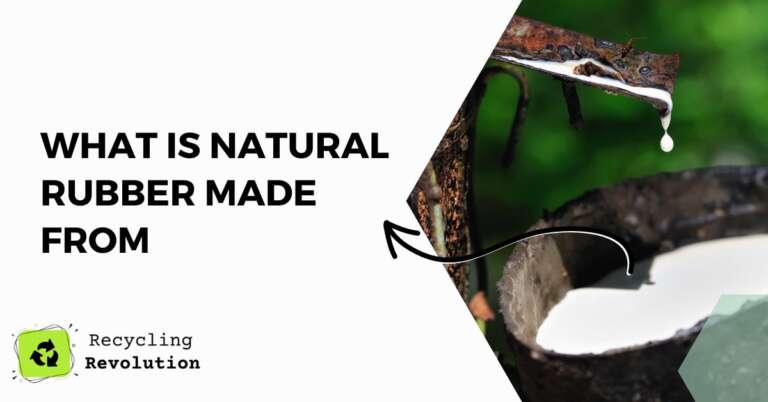Natural rubber, a wonderful and highly versatile material, is an everyday marvel whose origins lie deeply rooted in the natural world. Found in a plethora of products, from erasers to vehicle tires, natural rubber is a durable, resilient, and pliable substance that has shaped our modern lives in more ways than you may realize.
TL;DR: Natural rubber is derived from the milky-white sap or latex harvested from the Hevea brasiliensis tree, also known as the rubber tree. It’s an environmentally intensive process and requires specific climate conditions, raising significant environmental concerns.
Here are a few things that we can find natural rubber being used today:
| Product | Types of Natural Rubber Replacement |
|---|---|
| 1. Vehicle Tires | Bio-rubber derived from dandelions, guayule shrubs |
| 2. Medical Gloves | Nitrile rubber, which is a type of synthetic rubber |
| 3. Shoe Soles | Bio-rubber derived from Russian dandelions |
| 4. Condoms | Polyurethane or synthetic “latex” |
| 5. Erasers | Vinyl or synthetic rubber |
| 6. Wetsuits | Limestone neoprene, a type of synthetic rubber |
| 7. Waterproof Coatings | Silicone, a type of synthetic rubber |
| 8. Adhesives | Acrylic adhesives, made from synthetic polymers |
The Source of Natural Rubber: Hevea brasiliensis
At the heart of the matter is the Hevea brasiliensis tree. Native to the Amazon region, these trees produce a milky-white sap or latex when their bark is carefully incised or “tapped.” This latex is the raw material from which we derive natural rubber.
It’s crucial to understand that rubber trees require specific conditions to thrive, predominantly a hot, moist climate. Thus, countries near the equator, such as Thailand, Indonesia, and Malaysia, are leading producers of natural rubber.
I recommend considering the immense value of these trees. A single tree can produce latex for about 25 to 30 years, making it a long-term investment for rubber producers.
Harvesting and Processing: From Tree to Material
Harvesting rubber is a labor-intensive process that requires a delicate hand. Workers make careful incisions in the tree bark to allow the latex to flow out without damaging the tree. The latex is then collected in buckets, a process that must be repeated every few days.
Following collection, the latex undergoes coagulation, where it’s mixed with a coagulating agent, such as formic acid. This causes the latex to solidify, turning into a rubbery mass. This mass is then rolled out into sheets or processed into blocks, ready for shipping and further manufacturing.
The entire process from harvesting to processing requires significant human labor and resources, a factor that has led to both economic growth and exploitation in rubber-producing countries.
The Environmental Impact of Natural Rubber Production
Despite its natural origins, the production of natural rubber is not without significant environmental concerns. The demand for natural rubber has led to the expansion of rubber plantations, often at the expense of natural forests.
A study published in the journal ‘Environmental Research Letters’ noted that in the two decades from 1990 to 2010, global rubber plantations expanded by over 4.3 million hectares. Much of this expansion occurred in the biodiverse regions of Southeast Asia, leading to significant losses of natural habitats and associated biodiversity. Additionally, as the trees are non-native species in these plantation areas, the ecological balance is further disrupted.
Moreover, it might be worthwhile to consider the carbon footprint of natural rubber production. According to the World Wildlife Fund, each ton of dry natural rubber produced contributes to about 2.5 tons of carbon dioxide emissions. This statistic is primarily due to the energy-intensive processing methods and deforestation for rubber plantation expansion.
Is Natural Rubber Safe to Work with?
Working in rubber plantations often involves exposure to harsh conditions, including prolonged periods in the sun, heavy physical labor, and exposure to potentially harmful chemicals used in rubber processing. Consequently, there is an increased risk of health problems among plantation workers, including skin and respiratory issues.
Moreover, it might be worthwhile to consider the broader labor rights issues in these plantations. Often, workers are subjected to low wages, long working hours, and inadequate safety measures. Advocating for fair labor practices in the industry is, therefore, a critical concern.
Alternatives to Natural Rubber and Sustainable Practices
Given the environmental impacts, the search for sustainable alternatives to natural rubber is gaining momentum. Some alternatives include synthetic rubber derived from petroleum and bio-rubber produced from genetically modified plants or microbes. However, each of these alternatives presents its own set of challenges, including dependence on non-renewable resources and potential bio-safety concerns.
A useful suggestion would be to advocate for sustainable rubber farming practices. This could include measures such as agroforestry (intermixing rubber trees with other crops), reducing the use of fertilizers and pesticides, and promoting fair tradeand labor practices.
The Challenge of Rubber Waste Management
Natural rubber products, especially tires, contribute significantly to global waste. According to the Environmental Protection Agency, the US alone generates about 290 million scrap tires annually. These tires, if not properly managed, can cause significant environmental issues, including becoming breeding grounds for mosquitoes and other disease vectors.
Recycling initiatives are a key solution to this problem. I recommend supporting programs that repurpose rubber waste into useful products like playground surfaces, asphalt, and even energy in waste-to-energy plants. Such initiatives not only help manage waste but also conserve the resources needed for new rubber production.
Innovation in Rubber Production and Usage
Technological advancements and innovative practices are transforming the rubber industry. For instance, scientists are exploring ways to genetically modify the Hevea brasiliensis tree to increase its latex yield and resistance to diseases. Similarly, research is underway to develop more energy-efficient and less polluting rubber processing methods.
A useful suggestion would be to keep an eye on these developments. They not only indicate the future of the industry but also offer investment and business opportunities.
Government Policies and Regulations
Government policies play a crucial role in shaping the rubber industry. Regulations can help promote sustainable practices, protect workers’ rights, and manage the environmental impact of rubber production.
International certification schemes, such as the Forest Stewardship Council (FSC) and the Programme for the Endorsement of Forest Certification (PEFC), also play a role in promoting responsible rubber production.
Conclusion
In conclusion, natural rubber is a remarkable material that originates from the sap of the Hevea brasiliensis tree. Its production involves labor-intensive methods and environmental impacts that cannot be overlooked, including deforestation, biodiversity loss, and significant carbon emissions. As consumers and global citizens, it’s essential to promote and support sustainable farming practices and the development of eco-friendly alternatives.
FAQ
Are there any eco-friendly alternatives to natural rubber?
Yes, alternatives include synthetic rubber derived from petroleum and bio-rubber produced from genetically modified plants or microbes. However, each presents its own set of challenges.
What measures can promote sustainable rubber farming?
Measures such as agroforestry, reducing the use of fertilizers and pesticides, and promoting fair trade and labor practices can contribute to sustainable rubber farming.
Is the rubber tree native to Southeast Asia?
No, the rubber tree, Hevea brasiliensis, is native to the Amazon region. It was introduced to Southeast Asia due to its suitable climate conditions.
What are the leading countries in natural rubber production?
Countries near the equator, such as Thailand, Indonesia, and Malaysia, are leading producers of natural rubber due to their hot, moist climates.

